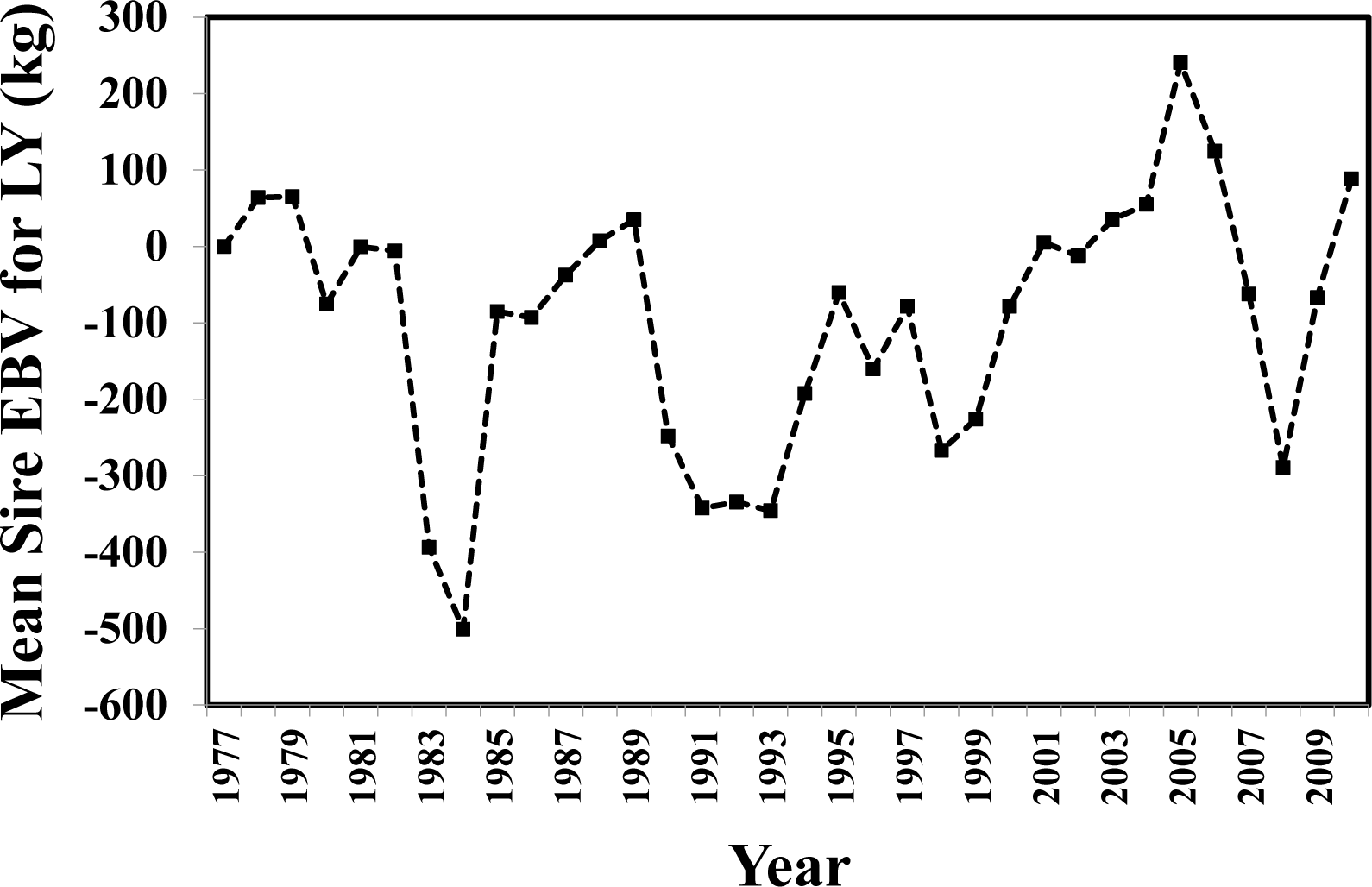Albuquerque LG, Keown JF, Van Vleck LD. 1996. Genetic parameters of milk yield, fat and protein yields in the first three lactations using an animal model and restricted maximum likelihood. Brazilian J Genet 19:79–86.
Ali TE, Schaeffer LR. 1987. Accounting for covariance among test-day milk yields in dairy cows. Can J Anim Sci 67:637–644.

Arnold JW, Bertrand JK, Benyshek LL. 1992. Animal model for genetic evaluation of multibreed data. J Anim Sci 70:3322–3332.


Atil H, Khattab AS. 2005. Estimation of genetic trends for productive and reproductive traits of Holstein Friesian cows in Turkey. Pakistan J Bio Sci 8:202–205.

Batra TR. 1986. Comparison of two mathematical models in fitting lactation curves for pure line and cross line dairy cows. Can J Anim Sci 66:405–414.

Cilek S, Sahin E. 2009. Estimation of some genetic parameters (heritability and repeatability) for milk yield in the Anatolian population of Holstein cows. Archiva Zootechnica 12:57–64.
Demeke S, Neser FWC, Schoeman SJ. 2004. Estimates of genetic parameters for Boran, Friesian, and crosses of Friesian and Jersey with the Boran cattle in the tropical highlands of Ethiopia: milk production traits and cow weight. J Anim Breed Genet 121:163–175.

Elzo MA, Famula TR. 1985. Multibreed sire evaluation within a country. J Anim Sci 60:942–952.

Epaphras A, Karimuribo ED, Msellem SN. 2004. Effect of season and parity on lactation of crossbred Ayrshire cows reared under coastal tropical climate in Tanzania. Livest Res Rural Dev. 6:16
http://www.cipav.org.co/lrrd/lrrd16/6/epap16042.htm consulted on 10/06/2012)
Espinoza AP, Villavicencio JLE, Gonzalez-Pena D, Iglesias DG, Pena RLDL, Almeida FR. 2007. Estimation of covariance components for the first four lactations in Holstein cattle according to different models. Zootecnia Trop 25:9–18.
Gebreyohannes G, Koonawootrittriron S, Elzo MA, Suwanasopee T. 2013. Fitness of lactation curve functions to daily and monthly test-day milk data in an Ethiopian dairy cattle population. Kasetsart J Nat Sci 47:60–73.
Gilmour AR, Cullis BR, Welham SJ, Thompson R. 2009. ASREML Discovery Reference Manual. NSW Agric.; Australia:
Gradiz L, Alvarado L, Kahi AK, Hirooka H. 2009. Fit of Wood's function to daily milk records and estimation of environmental and additive and non-additive genetic effects on lactation curve and lactation parameters of crossbred dual purpose cattle. Livest Sci 124:321–329.

Haile A, Joshi BK, Ayalew W, Tegegne A, Singh A. 2011. Genetic evaluation of Ethiopian Boran cattle and their crosses with Holstein Friesian for growth performance in central Ethiopia. J Anim Breed Genet 128:133–140.


Hoekstra J, Van Der Lugt AW, Van Der Werf JHJ, Ouweltjes W. 1994. Genetic and phenotypic parameters for milk production and fertility traits in upgraded dairy cattle. Livest Prod Sci 40:225–232.

Kahi AK, Thorpe W, Nitter G, Baker RL. 2000. Crossbreeding for dairy production in the lowland tropics of Kenya I. Estimation of individual crossbreeding effects on milk production and reproductive traits and on cow live weight. Livest Prod Sci 63:39–54.

Koonawootrittriron S, Elzo MA, Tumwasorn S, Nithichai K. 2002. Estimation of covariance components and prediction of additive genetic effects for first lactation 305-d milk and fat yields in a Thai multibreed dairy population. Thai J Agric Sci 35:245–258.
Koonawootrittriron S, Yodklaew P, Elzo MA, Suwanasopee T. 2012. Association between milk production and Holstein fraction of upgraded dairy cattle in the Thai tropics. In : ADSA-AMPA-ASAS-CSAS-WSASAA Joint Annual Meeting; Phoenix, AZ. July 15–19, 2012.
Mashhadi MH, Kashan NEJ, Nassiry MR, Torshizi RV. 2008. Prediction breeding value and genetic parameter in Iranian Holstein bulls for milk production traits. Pak J Biol Sci 11:108–112.


Montaldo HH, Castillo-Juarez H, Valencia-Posadas M, Cienfuegos-Rivas EG, Ruiz-Lopez FJ. 2010. Genetic and environmental parameters for milk production, udder health, and fertility traits in Mexican Holstein cows. J Dairy Sci 93:2168–2175.


SAS. 2003. SAS OnlineDoc 9.1.3. SAS Institute Inc; Cary, NC, USA:
Seangjun A, Koonawootrittriron S, Elzo MA. 2009. Characterization of lactation patterns and milk yield in a multibreed dairy cattle population in the central Thailand. Kasetsart J Nat Sci 43:74–82.
Stanton TL, Jones LR, Everett RW, Kachman SD. 1992. Estimating milk, fat and protein lactation curve with a test-day model. J Dairy Sci 75:1691–1770.


Tekerli M, Akinci Z, Dogan I, Akcan A. 2000. Factors affecting the shape of lactation curves of Holstein cows from the Balikesir Province of Turkey. J Dairy Sci 83:1381–1386.


Van Der Werf JHJ, De Boer W. 1989. Estimation of genetic parameters in a crossbred population of Black and White dairy cattle. J Dairy Sci 72:2615–2623.

Varona L, Moreno C, Cortes LAG, Altarriba J. 1998. Bayesian analysis of Wood’s lactation curve for Spanish dairy cows. J Dairy Sci 81:1469–1478.


Willham RL, Pollak E. 1985. Theory of heterosis. J Dairy Sci 68:2411–2417.

Wolf J, Zavadilova L, Nemcova E. 2005. Non-additive effects on milk production in Czech dairy cows. J Anim Breed Genet 122:332–339.


Yilmaz I, Eyduran E, Kaygisiz A, Javed K. 2011. Estimates of genetic parameters for lactation shape parameters with multivariate statistical technique in Brown Swiss cattle. Int J Agric Biol 13:174–178.
Yohannes G, Zelalem Y, Gizachew B, Alemu GW, Sendros D. 2002. Milk yield and reproductive performance of Boran cows and growth rate of their calves under partial suckling method. p. 367–378. In : ESAP (Ethiopian Society of Animal Production) Proceedings of 9th Annual Conference of the ESAP held in Addis Ababa; Ethiopia. August 30–31; 2001.






 PDF Links
PDF Links PubReader
PubReader ePub Link
ePub Link Full text via DOI
Full text via DOI Full text via PMC
Full text via PMC Download Citation
Download Citation Print
Print







